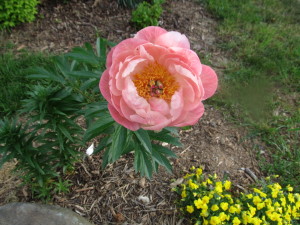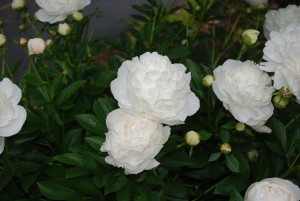Summer weather can be tough on the foliage of tree and herbaceous peonies tree (P. lactiflora). Here are some tips to ensure your peony plants will prosper for many years to come.
Keep foliage disease-free and prune off all badly infected with mildew or black spotted. Some varieties naturally shed their leaves (go dormant) early. Itoh hybrids and most hybrids maintain their foliage very late into growing season. Healthy foliage will build strong roots and increase numbers of flower buds next season.
Fertilize after flowering with granular 10-10-10 or equivalent. Usually 1-2 handfuls spread around the plant is adequate. Keep fertilizer a minimum of 6 inches away for the plant base. Mulch with an organic-based mulch such as chipped bark, composed shredded leaves, or straw to conserve soil moisture and prevent weed competition.
Deadhead your peonies, e.g.,prune off the spent flowers and seed pods. This will improve plant appearance through the long hoy summer ahead. Varieties with large blooms may have fallen over due to heavy rainfall. Many varieties will produce seeds, fall to the ground, and germinate. Eventually, seedlings grow and over time compete with the original peonies.
For foliar mildew problems, clip off all diseased or dead foliage and discard. If your area does not allow burning put it into the trash. Don’t compost diseased plant material since the spores will carry over into next year. Remove from the garden and throw in household trash or burn debris. The dead leaves are full of spores that may injure new spring foliage.
If you have additional gardening queries, contact your local Extension agent. He or she can suggest fungicides are approved in your state for peonies. Master Gardeners may also be knowledgeable area experts.
A great resource for peony information: Hollingsworth Peonies, P.O. Box 517, Hockessin, DE 19707. Telephone number: (302) 635-0140. For general information: nursery@hpeonies.com



 Posted in
Posted in 
